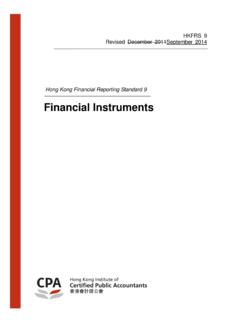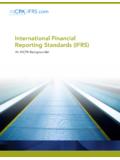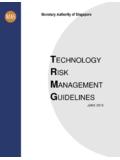Transcription of China Accounting Alert - EY
1 January 2016 China Accounting Alert The IASB issued a new standard that requires lessees to recognize most leases on their balance sheets. The new standard will be effective from 1 January 2019 with limited early application permitted. The HKICPA released its new and revised auditor reporting standards, which will be effective for audits of financial statements for periods ending on or after 15 December 2016. IASB issues new leases standard Highlights The International Accounting Standards Board (IASB or Board) issued IFRS 16 Leases (IFRS 16 or the new standard), which requires lessees to recognize assets and liabilities for most leases.
2 For lessors, there is little change to the existing Accounting in IAS 17 Leases. The new standard will be effective for annual periods beginning on or after 1 January 2019. Early application is permitted, provided the new revenue standard, IFRS 15 Revenue from Contracts with Customers, has been applied, or is applied at the same date as IFRS 16. Key considerations Lessee Accounting Initial recognition and measurement Lessees are required to initially recognize a lease liability for the obligation to make lease payments and a right-of-use asset for the right to use the underlying asset for the lease term.
3 The lease liability is measured at the present value of the lease payments to be made over the lease term. The right-of-use asset is initially measured at the amount of the lease liability, adjusted for lease prepayments, lease incentives received, the lessee s initial direct costs ( , commissions) and an estimate of restoration, removal and dismantling costs. Lessees are permitted to make an Accounting policy election, by class of underlying asset, to apply a method like IAS 17 s operating lease Accounting and not recognize lease assets and lease liabilities for leases with a lease term of 12 months or less ( , short-term leases).
4 Lessees also are permitted to make an election, on a lease-by-lease basis, to apply a method similar to current operating lease Accounting to leases for which the underlying asset is of low value ( , low-value assets). Subsequent measurement Lessees accrete the lease liability to reflect interest and reduce the liability to reflect lease payments made. The related right-of-use asset is depreciated in accordance with the depreciation requirements of IAS 16 Property, Plant and Equipment. For lessees that depreciate the right-of-use asset on a straight-line basis, the aggregate of interest expense on the lease liability and depreciation of the right-of-use asset generally results in higher total periodic expense in the earlier periods of a lease.
5 Lessees remeasure the lease liability upon the occurrence of certain events ( , change in the lease term, change in variable rents based on an index or rate), which is generally recognized as an adjustment to the right-of-use asset. Lessees apply alternative subsequent measurement bases for the right-of-use asset under certain circumstances in accordance with IAS 16 and IAS 40 Investment Property. Right-of-use assets are subject to impairment testing under IAS 36 Impairment of Assets. Presentation Right-of-use assets are either presented separately from other assets on the balance sheet or disclosed separately in the notes.
6 Similarly, lease liabilities are either presented separately from other liabilities on the balance sheet or disclosed separately in the notes. Depreciation expense and interest expense cannot be combined in the income statement. In the cash flow statement, principal payments on the lease liability are presented within financing activities; interest payments are presented based on an Accounting policy election in accordance with IAS 7 Statement of Cash Flows. Lessor Accounting Initial recognition and measurement The Accounting by lessors under the new standard is substantially unchanged from today s Accounting in IAS 17.
7 Lessors classify all leases using the same classification principle as in IAS 17 and distinguish between two types of leases: operating and finance leases. For operating leases, lessors continue to recognize the underlying asset. For finance leases, lessors derecognize the underlying asset and recognize a net investment in the lease similar to today s requirements. Any selling profit or loss is recognized at lease commencement. Subsequent measurement For operating leases, lessors recognize lease income on either a straight-line basis or another systematic basis that is more representative of the pattern in which benefit from the use of the underlying asset is diminished.
8 For finance leases, lessors recognize interest income for the accretion of the net investment in the lease and reduce that investment for payments received. The net investment in the lease is subject to the derecognition and impairment requirements in IFRS 9 Financial Instruments. Transition The new standard permits lessees to use either a full retrospective or a modified retrospective approach on transition for leases existing at the date of transition, with options to use certain transition reliefs. Further details about the new leases standard are found in EY s IFRS Developments Issue 117.
9 2 China Accounting Alert Get ready for the new style auditor s report In August 2015, the hong kong Institute of Certified Public Accountants (the HKICPA ) released its new and revised auditor reporting standards, which are designed to significantly enhance the value of the auditor s report for investors and other users of financial statements. The new and revised auditor reporting standards refer principally to the new hong kong Standard on Auditing ( HKSA ) 701 Communicating Key Audit Matters in the Independent Auditor s Report and a number of revised HKSAs, including HKSA 700 (Revised) Forming an Opinion and Reporting on Financial Statements, HKSA 705 (Revised) Modifications to the Opinion in the Independent Auditor s Report and HKSA 570 (Revised) Going Concern.
10 In August 2015, the HKICPA also issued HKSA 720 (Revised) The Auditor s Responsibilities Relating to Other Information which requires a separate section in the auditor s report addressing the auditor s responsibilities for other information included in the annual report. The new and revised auditor reporting standards will be effective for audits of financial statements for periods ending on or after 15 December 2016. The requirements in these HKICPA s standards are the same as those in the equivalent International Standards on Auditing ( ISAs ) issued by the International Auditing and Assurance Standards Board (the IAASB ), which also have the same effective date.













